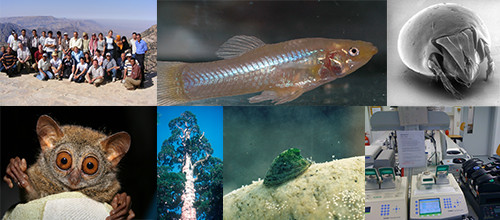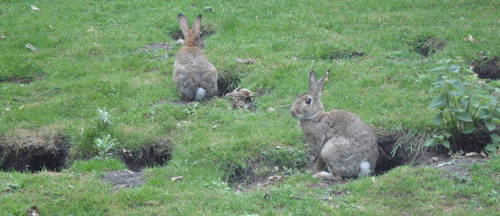- Institut OED
- Institut ZN
- Institut MBW
- Abt. für Didaktik
- Einrichtungen
- Forschung
- Forschungsthemen
Research and CV Bruno Streit (International Version)
A: Objectives
Biological communities often exhibit temporal variations in species composition, in population sizes and in interactions. They are the consequences of successional processes, of climatic shifts, of invasive species and other influences. Many changes have been strongly enforced by human activities and in part are unprecedented for nature, such as the global mixing of species or contamination with an enormous variety of man-made organic compounds. Natural and anthropogenic ecological shifts may both be observed within short times, but often become evident only after decades to millennia. It is especially the evolutionary processes that usually proceed at a rather slow pace, manifesting significant biological changes on a longer perspective only. Among these are changes in genotype frequencies and general genetic arrangements as results from natural or anthropogenic selective forces or by other evolutionary drivers. Genetic alterations may affect physical appearance, physiological adaptations or even personality traits. Ecological and evolutionary shifts go hand in hand and continually shape animal, plant and human populations, their health and their interactions with each other and their environments. These kinds of integrative approaches are crucial in our 'Evolutionary Ecology' approach.
Our research and our teaching, as well as student excursions, have led us to different parts of the planet. A DAAD supported 2007 multi-national excursion, bringing together students from different countries of the Middle East as well as a selected group of Frankfurt students, as shown on the top left photo in Jordan. The Middle East region has actually experienced the longest tradition of agricultural and pastural activities on earth, since more than 10.000 years, with, however, most sincere influences on soil, hydrology, biology and landscape appearance.
A central issue of our general research and teaching is the phenomenon of global change and biodiversity loss resulting ultimately from the strongly increasing overall dominance by the roughly 7.8 billion humans, who may live on earth in 2020 (based on UN approximations). When Bruno Streit was born in 1948, the planet's population was about 2,45 billion, and when his group started working at Frankfurt in 1985, it was approximately 4,85 billion and the biodiversity threat was still quite more moderate on a world-wide scale.

B: Research at Frankfurt University in the past 10-15 years
Another research area covered sexual behavior, communication and
evolutionary ecology of tropical freshwater fish species in the Poeciliidae
family ('guppy' or 'molly'; some species of this family are appreciated as ornamental fish in home aquaria). These biological 'model systems' were introduced in our lab by PD Dr. Martin Plath, now professor at the
University of Yangling (near Xian) in China. We aimed to better understand social
communications and courtship behavior between sexes in the genus Poecilia, as well as general personality traits and their differences. Various PhD theses resulted from these studies: D. Bierbach,
J. Jourdan, C. Sommer-Trembo, C. Zimmer. Also
aspects of geographic distribution, invasion of European river and lake systems
und speciation within this fish family were studied.
An integrative biological-geological research focus has been set by PD Dr. Sebastian Klaus, former scientific assistant and supported by DFG until 2018: He studied in detail, together with his students, palaeobiogeography and systematics of freshwater crabs (photo bottom right). By combining phylogenetic methods with geological and fossil data he could disentangle both, the phylogeographic evolution of crabs and the river catchment dynamics resulting from sea level fluctuations and erosional landscape modifications during the paleogene and neogene periods. His focus originally was in the Mediterranean, later in South-East Asia. Various theses have resulted from this research line (e.g., L. Hartmann).
Water fleas of the genus Daphnia
have proved to be excellent candidates for the study of ecologcial and evolutionary
processes including the process of hybridization. They are tiny planctonic freshwater crustaceans of 1-3 mm in length (see photo
at the bottom) and easy to rear and their genome has been fully
sequenced by other labs. Our main research focus was on the hybridizing species
complex Daphnia galeata, D. cucullata and D. hyalina.
The studies were mostly designed and supervised by PD Dr. Klaus Schwenk, now
professor at the University of Landau. Based on our research and being aware of the widespread significance of animal species hybridizations up to primates (only a couple years later stated also for the history of mankind by other labs), we had organized an international symposium in 2006 with several high-ranked scholars working on this field. The major results have been published by us in a special journal issue of the Proceedings of the Royal Society in 2008.
With regards to primates, members of the group studied on south-east Asian tarsiers, a research line introduced by the former scientific assistant Dr. Stefan Merker, today head of the zoology department at the State Museum for Natural Sciences, Stuttgart. Tarsiers are tiny tree-dwelling primates that live nocturnally and preferentially feed upon arthropods. They are dwarfed representatives of ancient primates, separated some 50 to 60 million years ago from the "higher" primate lines, in which Humans (genus Homo) are as well. The studies concentrated on aspects of mtDNA peculiarities, speciation and geographic distribution, based on both, field studies and genetic analyses. Merker had described a new tarsier species, Tarsius wallacei, in the International Journal of Primatology in 2010, a discovery leading to a world-wide public attention.

In a more local study we
analyzed European rabbit populations (Oryctolagus cuniculus, see photo on top). This species was originally introduced from the Iberian Peninsula to Central Europe, probably during the
Middle Ages. We studied aspects of their biology, parasitology and
ethology, comparing urban with rural populations (PhD thesis by M. Ziege, and
selected diploma and MSc theses). We could show that (at that time) the roughly 4.000 to
6.000 rabbit city dwellers in Frankfurt revealed simpler social entities, but at the
same time they experienced less environmental stress (as measured by fear and flight reactions and other parameters) than their rural relatives.
Various single projects on reptiles, amphibians and the wild cat resulted from cooperations with scientists from Senckenberg, especially professor G. Köhler and Dr. C. Nowak. Among them were the theses by M. Jansen, A. Schulze, S. Lotzkat, A. Hertz, K. Steyer, and J. Köhler.
A strong Climatic Change focus was established by the 2008-2014 cooperations of the department with the Biodiversity and Climate Research Centre (BiK-F), where the former PhD student and scientific assistant, Dr. Markus Pfenninger, got a cooperation professorship (today professor of Mainz University). Among the theses resulting from the BiK-F engagement was one by Mathilde Cordellier about the predicted biogeographical distributions of future freshwater snail populations (today junior professor at Hamburg University).

Thanks to a cooperation with WWF Germany, the former PhD candidate S. Ziegler was able to successfully work on ivory profiling by isotopes (C-13, N-15, O-18, δ2H, S-34) and thus to provide a potentially helpful tool for authorities to detect the probable (approximate) origin, where legal or non-legal tusk ivory may come from. – The photo shows an elephant group in South Africa (photo B.S.).
In cooperation with different partners (M. Plath, T. Wronski, M. Pfenninger) the group also studied behavior of Arabian gazelles (especially Gazella dorcas) and analyzed phylogenetic relationships. Even population size shifts in prehistorical and historical times were roughly estimated by applying coalescent theory on nucleotide sequences of the cytochrome b gene and a 540 bp fragment of the mitochondrial control region. By the way: This species has been mentioned various times also in the Tanakh (Old Testament), but now has disappeared from most of its historical distribution range.
October 2019

C: CV Bruno Streit
Studying natural sciences with a focus on zoology at the University of Basel (Switzerland), Bruno Streit graduated with field studies on temperature stress in the river Aare near a nuclear plant water effluent. His doctoral thesis was on the ecophysiology and the energy and carbon flow (measured by 14C labelling) within populations of the European freshwater limpet Ancylus fluvaitlis, grazing on bottoms of rivers and lakes. These studies were performed at the Limnological Institute of Konstanz (Germany). He continued as a postdoc still at the same lab with studies on the bioaccumulation and ecotoxicity of agrochemicals in aquatic environments and food chains. After his return to Basel he wrote his habilitation (qualification degree to become a formal professor) in zoology and took over official chair duties (Lehrstuhlvertretung), focussing in research on soil ecology of microarthropods and heavy metal ecotoxicology. In 1982 he moved to Paul Ehrlich's lab at Stanford University, California, concentrating on population biology, from where he returned 26 months later to Europe to take over a full professorship at Frankfurt on April 1, 1985. In the following, he expanded his research also to the evolutionary biology of selected freshwater, marine and terrestrial animals. A long-term key issue was applying aspects of population biology on nature conservation (Natur- und Artenschutz), supported by the former federal BMBF ministry. Another focus was on the cooperation and P.I. at the Biodiversity and Climate Research Centre, a joint institution of Goethe University and Senckenberg from 2008-2014 (BiK-F, today part of Senckenberg). He held various positions within the University, such as dean for several years and founding director of the Institute of Ecology and Evolution. One of his more political goals was the strengthening and tightening of interactions between Goethe University and non-university institutions in the Frankfurt area, that work on issues of biodiversity, nature conservancy and sustainability management. Thus, he was co-founder and thereafter spokesman and coordinator of BioFrankfurt, the Network for Biodiversity (www.biofrankfurt.de) from the beginning in 2004 until 2019. Since his formal retirement from the University staff in 2013, he has been appointed continuously as a Senior Professor for evolutionary biology and biodiversity studies at the BioSciences Division (Fachbereich Biowissenschaften). Bruno Streit is author of more than 230 scientific papers, author/coauthor or editor of 12 books in German, English and Vietnamese as well als of various special topic issues of scientific journals and brochures. His further interests are in pre-history and history, cultural shifts and the evolution of languages. He is currently chairman of the 'Zoo-Freunde Frankfurt e.V.', the friends' association of the traditional Frankfurt Zoo.

Appendix: A currently still on-going BioFrankfurt project on urban wilderness ("Städte wagen Wildnis") won the award as an 'Excellent Project in 2018' within the UN Decade on Biological Diversity. The group, consisting of Pia Ditscher, Stefanie Preußer, Dr. Christiane Frosch and of Bruno Streit as P.I. (until 2019), is responsible for the overall communication of urban wilderness projects in the cities of Frankfurt, Hannover and Dessau (the city of the famous Bauhaus design school). A supplementary project by Bruno Streit has focused on local communication strategies about wilderness area developments within the Frankfurt city boundaries (funded by the Flughafenstiftung 2016-2019, co-P.I.: Christiane Frosch).
- Aktuelles und Presse
- Pressemitteilungen
- Öffentliche Veranstaltungen
- Uni-Publikationen
- Aktuelles Jahrbuch
- UniReport
- Forschung Frankfurt
- Aktuelle Stellenangebote
- Frankfurter Kinder-Uni
- Internationales
- Outgoings
- Erasmus / LLP
- Goethe Welcome Centre (GWC)
- Refugees / Geflüchtete
- Erasmus +
- Sprachenzentrum oder Fremdsprachen
- Goethe Research Academy for Early Career Researchers
- Forschung
- Research Support
- Forschungsprojekte, Kooperationen, Infrastruktur
- Profilbereich Molecular & Translational Medicine
- Profilbereich Structure & Dynamics of Life
- Profilbereich Space, Time & Matter
- Profilbereich Sustainability & Biodiversity
- Profilbereich Orders & Transformations
- Profilbereich Universality & Diversity





